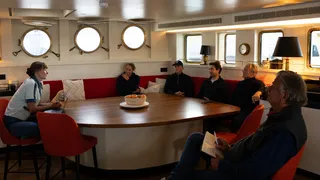About the expedition
Superyacht owner Erik Vonk has opened his yacht Scintilla Maris to Dr. Paige Maroni and Tim Macdonald for a week-long scientific expedition along Iceland’s wild East Coast in partnership with Yachts for Science – the initiative connecting yacht owners with ocean researchers. Read Vonk's daily updates from life on board below, offering a rare glimpse into how luxury yachting can help power real marine discoveries...
Cool facts about Scintilla Maris
Key specs:
Length: 45.7m
Builder: Damen Maaskant
Delivered: 1989
Conversion: Completed from a fishing trawler into an explorer yacht in September 2023
Yacht for sale price: Listed with Burgess, asking €18,950,000
Yacht available for charter: Yacht for rent with Burgess, from $175,000 per week
BOAT International stepped on board Scintilla Maris in February 2024 to learn more about the conversion of the working boat into the comfort of an expedition yacht...
Read More/For sale: On board the converted 46m Damen Maaskant yacht Scintilla Maris
